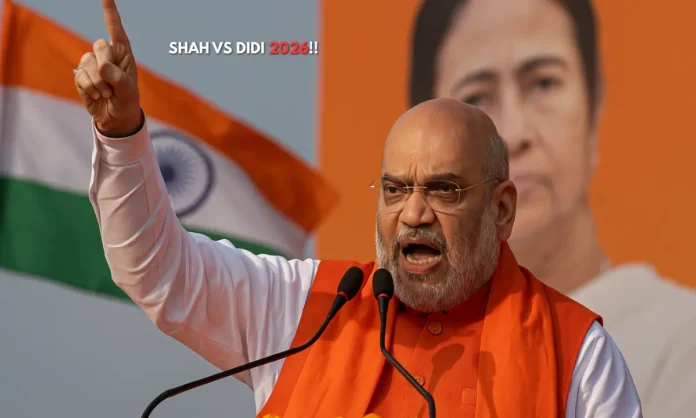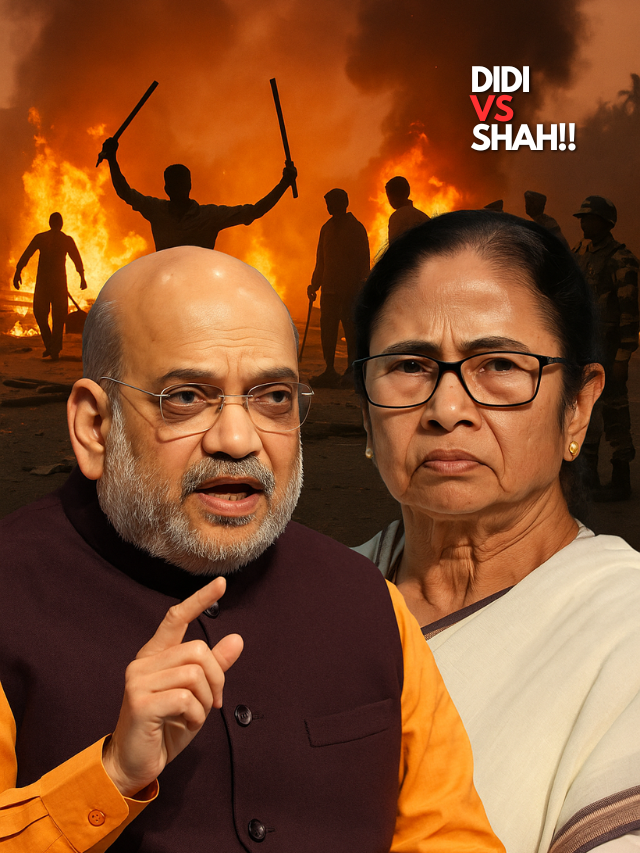SUMMARY
- Amit Shah promises BJP will win West Bengal in 2026, challenges Mamata to hold “violence-free” elections.
- Murshidabad riots, border infiltration, and Operation Sindoor become flashpoints in the Home Minister’s attack.
- TMC hits back, accusing the Centre of election mismanagement and politicising national security.
Bengal’s Turning Point? Shah’s 2026 Election Message Raises the Stakes
Home Minister Amit Shah’s high-voltage speech in Kolkata has jolted West Bengal’s political landscape ahead of the 2026 Assembly polls. Asserting that the “end” of Mamata Banerjee’s rule was imminent, Shah’s speech combined electoral bravado with sharp allegations—from rigged elections to communal violence and lax border security. The timing was calculated: Prime Minister Narendra Modi had only days earlier invoked Operation Sindoor at an Alipurduar rally, triggering a bitter war of words with the Trinamool Congress.
Shah’s remarks came at the Vijay Sankalp Karyakarta Sammelan in Kolkata, a strategically staged rally amid BJP’s internal reorganisation in the state. But this wasn’t merely a routine political address—it was a signal of the party’s renewed attempt to energize its cadre, consolidate Hindu votes, and retake lost momentum after its 2021 defeat.
Targeting issues such as the Murshidabad riots, cross-border infiltration, and the school recruitment scam, Shah offered a narrative where state security, religious identity, and corruption intersect with electoral urgency. TMC’s defensive pushback—framing Shah’s remarks as deflections from central failures—suggests that the 2026 election is already shaping into a deeply polarised, high-stakes contest. In this article, we explore the full arc: BJP’s strategic framing, TMC’s counteroffensive, and the real test of democratic integrity in West Bengal.
Amit Shah drops a BOMB in Bengal! 🔥
— महावीर जैन, ಮಹಾವೀರ ಜೈನ, Mahaveer Jain (@Mahaveer_VJ) June 1, 2025
"I PROMISE — the day TMC is voted out of Power, even if the killers of BJP karyakartas (workers) are BURIED UNDERGROUND, we will DIG THEM OUT!" ⚔️💥
Justice is coming… 🥶🛑 pic.twitter.com/VyE00VA20r
Shah’s Script: From Murshidabad to Sindoor, a Full-Frontal Assault on Mamata
- Shah directly accused Mamata Banerjee of sponsoring the Murshidabad riots and shielding infiltrators.
- He claimed that BJP had to approach the High Court to deploy BSF during the April 11–12 communal clashes.
- Linking Operation Sindoor to Hindu sentiments, he criticised Banerjee for “appeasing Muslim votes.”
Standing before a crowd of party loyalists at the Netaji Indoor Stadium, Amit Shah declared that Mamata Banerjee’s government was nearing its “expiry date.” His words, however, were more than just political theatre—they were a calibrated escalation. “I dare you to hold elections without violence and rigging,” he said, drawing cheers from the audience. He framed TMC’s governance not just as corrupt or ineffective, but as actively complicit in enabling communal unrest.
The Home Minister alleged that the Murshidabad riots, which claimed three lives and displaced hundreds, were allowed to fester because the state government blocked BSF deployment. “Only when BJP workers knocked on the High Court’s doors did the BSF arrive,” he said. His critique painted the Banerjee administration as one that weaponizes state machinery to suppress political rivals and minority communities alike.
The speech took a cultural-religious turn when Shah invoked Operation Sindoor—India’s retaliatory military strike following the Pahalgam terror attack. Using it as a metaphor of Hindu identity and national security, Shah accused Mamata Banerjee of opposing the operation “to appease the Muslim vote bank.” This controversial framing attempts to position the BJP as both the protector of national pride and the political representative of “wronged” Hindu voters.
TMC Fires Back: Election Commission, Not Mamata, Runs the Polls
- TMC dismissed Shah’s allegations, calling them a distraction from central failures in law and order.
- Party leaders reminded Shah that the Election Commission—not the State—manages elections.
- Banerjee previously backed Operation Sindoor but accused Modi of “politicising” it.
The Trinamool Congress was quick to counterattack. Within hours of Shah’s speech, the party held a press conference and posted a sharp rebuke online: “Are you admitting that free and fair elections aren’t possible even under your watch? Don’t pass the buck.” This rhetorical pivot shifts accountability squarely onto the Centre and the Election Commission—entities that TMC argues are being used as BJP’s proxies in Bengal.
On the Murshidabad riots, TMC reiterated that communal tensions flared due to protests surrounding the Waqf (Amendment) Act, not because of any state orchestration. Moreover, they defended Mamata Banerjee’s broader law-and-order record, pointing out that Bengal had seen fewer communal incidents compared to BJP-ruled states like Uttar Pradesh.
Crucially, the party rejected claims that Mamata opposed Operation Sindoor. They shared archived clips and statements where she supported the military response post-Pahalgam attack. Her critique, they argue, was not about the operation itself but about the timing and tone of political speeches made during sensitive all-party diplomatic missions.
Identity, Security, and the Polls: Bengal’s Road to 2026
- BJP’s use of Operation Sindoor and border infiltration frames the election around nationalism and identity.
- TMC continues to project governance competence, minority protection, and Centre-State autonomy.
- The political climate signals a deeply polarised contest, with cultural codes playing an outsized role.
The contours of the 2026 West Bengal election are being drawn in unusually stark terms. For the BJP, this is not merely an electoral contest—it is a “civilisational” battle, symbolised by vermilion, border fences, and fallen soldiers. For the TMC, the stakes are framed around preserving federal dignity, protecting communal harmony, and resisting what they portray as authoritarian overreach.
Border infiltration is poised to become one of the BJP’s most potent weapons. With 864.5 km of the Indo-Bangladesh border in Bengal still unfenced, Amit Shah’s narrative of “infiltration under Mamata’s blessings” is aimed squarely at Hindu voters in sensitive districts like Cooch Behar, Malda, and Murshidabad. Meanwhile, Operation Sindoor is being deployed not just as foreign policy but as cultural symbolism in domestic politics.
Mamata Banerjee’s strategy, on the other hand, revolves around governance optics—public welfare, education, and women’s safety—alongside cautionary tales of central interference. Her political rhetoric also reflects a woman-versus-machine framing, often portraying herself as a lone fighter against a BJP-dominated institutional setup.
Countdown to Confrontation
With Amit Shah’s declaration, the Bengal 2026 electoral battlefield is officially activated. What we’re witnessing is not just a clash of parties, but a collision of ideological currents: nationalism vs federalism, religion vs secularism, and majoritarian identity vs pluralist resistance. Every speech, riot, and court order from here on will be weaponised for or against this narrative.
If the BJP succeeds in making this election a referendum on infiltration and Hindu pride, it may swing critical votes. If the TMC can convince voters that the central government is scapegoating Bengal while ignoring broader issues like employment and inflation, it might hold on.
What’s clear is that 2026 will not be a conventional election. It will be a referendum on Mamata Banerjee’s legacy, the BJP’s expansionist zeal, and the very idea of what Bengal stands for in the Indian republic.



